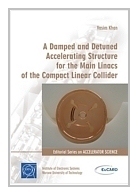|
||
• wydawnictwa polskie
• Zamów informacje o nowościach z wybranego tematu • kontakt
• Cookies na stronie |
A DAMPED AND DETUNED ACCELERATING STRUCRURE FOR THE MAIN LINACSKHAN V. - OF THE COMPACT LINEAR COLLIDERwydawnictwo: WYD PW , rok wydania 2011, wydanie Icena netto: A Damped and Detuned Accelerating Structure for the Main Linacs of the Compact Linear ColliderLinear colliders are an option for lepton collision at several TeV. The Compact Linear Collider (CLIC) aims at electron and positron collisions at a centre of mass energy of 3 TeV. In CLIC, the main accelerating structures are designer to operate at an X-band frequency of 12 GHz with an accelerating gradient of 100 MV/m. Two significant issues in linear accelerators that can prevent high gradient being achieved are electrical breakdown and wakefields. The baseline design for the CLIC main linacs relies on a small aperture size to reduce the break down probability and a strong damping scheme to suppress the wakefields. The strong damping scheme may have a higher possibility of electrical breakdown. In this thesis an alternative design for the main accelerating structures of CLIC is studiem and various aspects of this design are discussed. This design is known as a Damped and Detuned Structure (DDS) which relies on moderate damping and strong detuning of the higher order modes (HOMs). The broad idea of DDS is based upon the Next Linear Collider (NLC) design. The advantages of this design are: well damped wakefields, minimised rf breakdown probability and reduced size of the structure compared to the strong damping design. Procedures necessary to minimise the rf monopole fields and enhance the wakefield suppression are discussed. The rf as well as mechanical designs of a test structure are presented. This unique design forms the basis of this research and allows both the electric al breakdown and beam dynamics constraints to be simultaneously satisfied. 230 pages, Paperback Księgarnia nie działa. Nie odpowiadamy na pytania i nie realizujemy zamówien. Do odwolania !. |


